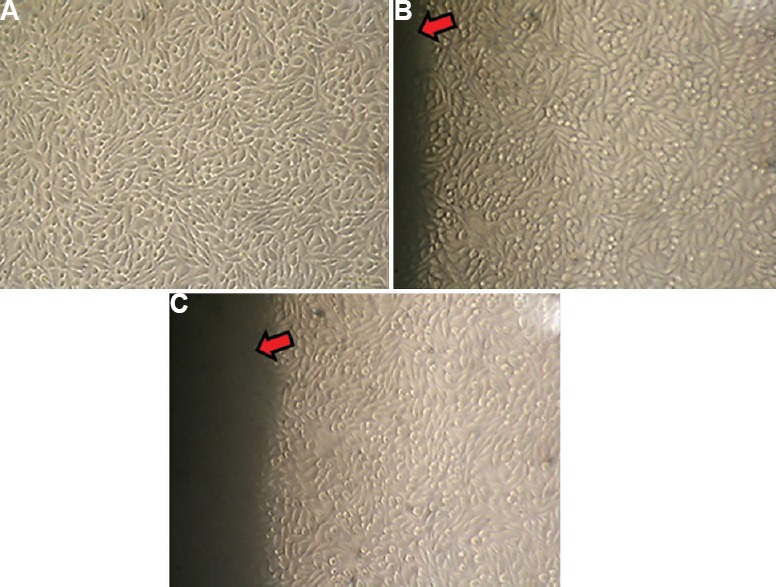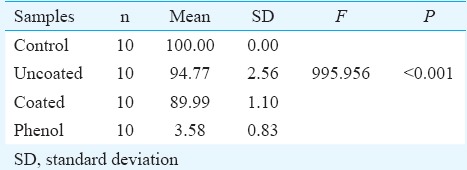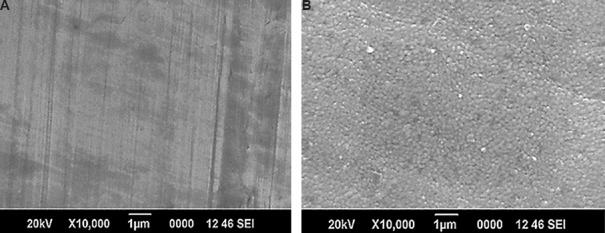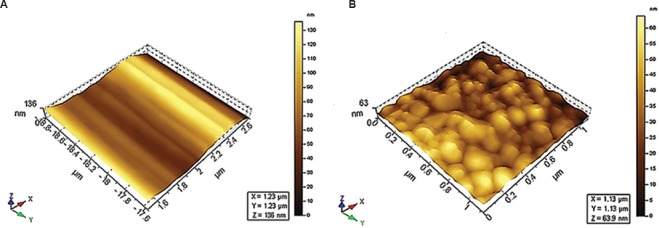Abstract
Background & objectives:
Fixed orthodontic treatment, an indispensable procedure in orthodontics, necessitates insertion of dental bands. Insertion of band material could also introduce a site of plaque retention. It was hypothesized that band materials with slow-release antimicrobial properties could help in sustained infection control, prevention of dental plaque formation and further associated health risks. Considering the known antimicrobial proprieties of silver, a coating of silver nanoparticle (SNP) onto the stainless steel bands was done and characterized for its beneficial properties in the prevention of plaque accumulation.
Methods:
Coatings of SNPs on conventional stainless steel dental bands were prepared using thermal evaporation technology. The coated dental bands were characterized for their physicochemical properties and evaluated for antimicrobial activity and biocompatibility. The physiochemical characterization of band material both coated and uncoated was carried out using scanning electron microscope, energy dispersive spectroscopy, atomic force microscopyand contact angle test. Biocompatibility tests for coated band material were carried using L929 mouse fibroblast cell culture and MTT [3-(4, 5-dimethyl thiazol-2-yl)-2, 5-diphenyl tetrazolium bromide] assay. Antimicrobial activity of coated band material against Gram-positive bacteria was tested.
Results:
A stable and uniform coating of SNPs was obtained. The coated band materials were biocompatible as well as possessed distinct antimicrobial activity.
Interpretation & conclusions:
The SNP coated dental bands could be potential antimicrobial dental bands for future clinical use. Further studies need to be done to validate the efficiency of coated band materials in oral environments.
Keywords: Antimicrobial, band, coating and silver nanoparticles
Fixed orthodontic treatment necessitates insertion of dental bands. Band insertion induces ecological changes of the oral microbiota by affecting its amount, composition, metabolic activity and pathogenicity, which clinically result in a higher incidence of largely reversible periodontal and microbial side effects. Frequently, persisting white spot lesions caused by decalcification can be observed around the banded tooth, even after completion of treatment. These side effects of fixed orthodontic therapy can be explained by the higher number of plaque retentive sites and impaired mechanical plaque removal after band insertion1.
Various dental procedures including routine oral hygiene efforts and gentle mastication may lead to entry of bacterial endotoxins from the oral cavity into the blood stream; precipitating as a local inflammatory response to complex systemic disturbances2. In addition to health risks, poor oral hygiene is shown to increase the orthodontic treatment time. Consequently, cells involved in the tooth movement such as osteoclasts, do not efficiently perform in an inflammatory environment3. Chlorhexidine mouthwashes suggested for reducing plaque accumulation and decalcification did not reduce Streptococcus mutans count even with higher concentrations4. Treatment of tooth with silver nitrate has been shown to retard the destructive action of dental caries upon the enamel5. A ‘containment effect’ of no bacterial inhibition was reported in a study on antibacterial properties of current orthodontic band cement samples surrounded by stainless steel bands6.
Hence, it was presumed that an antibacterial treatment of dental bands might prevent the accumulation of dental plaque. As silver is known to have antimicrobial properties, a coating of silver nanoparticles (SNPs) on stainless steel bands was prepared in this study and characterized for its physicochemical properties, antimicrobial activity and biocompatibility.
Material & Methods
The study was carried out at the Division of Tissue Engineering & Regeneration Technologies, Sree Chitra Tirunal Institute for Medical Sciences and Technology, Thiruvananthapuram, Kerala, India.
Silver ions were deposited on the stainless steel dental band material (Desires, India) by thermal evaporation technique using - Vacuum evaporation Unit (Indovision, India) at a vaccum of 5×10−5 millibar at 961°C for 10 min. The silver metal bar was kept over tungsten filament and vapourized to form a uniform coating of silver on the band material that was maintained at 26°C for one hour. The coated stainless steel bands were cut into 0.5 × 1 cm pieces for each experiment.
Physicochemical characterization of the coated surface
Scanning electron microscopy (SEM) & atomic force microscopy (AFM): The surface morphology of coated and uncoated stainless steel band materials was studied with scanning electron microscope (SEM) S - 2400 (Hitachi, Japan). Energy dispersive spectroscopy (EDS) spectra obtained from SEM were used to evaluate the surface elemental composition of the coated and uncoated band material. Surface topographic study of coated and uncoated stainless steel band materials was conducted with an atomic force microscope (Agilent 5500, USA with contact mode cantilevers).
Contact angle test: Contact angle of coated and uncoated surfaces was measured using video contact analyzer, OCA 15 plus and imaged using SCA 20 software (DataPhysics Instruments GmbH, Germany)7. The coated surface has an uneven topography due to the nanoparticles. Surface contact angle was evaluated using sessile drop method7. Deionized water (3 μl) or organic solvent was automatically dropped onto the film using a Gastight Hamilton precision syringe. Images of the droplet were captured within five seconds. For measurements of surface energy, three liquids were used, namely, water, ethyl glycol and glycerol. The baseline and the tangent were drawn using software, and the contact angles from both the sides of test liquid droplet were measured. The results were analyzed for the measurement of surface free energy (SFE)7.
Cytotoxic studies
Direct contact assay: Cytotoxicity evaluation of material was carried out by the direct contact assay and indirect contact test8 of extracts with a monolayer of L929 mouse fibroblast cells (National Centre for Cell Sciences, Pune) according to ISO 10993 standard. For direct contact test, L929 cells were seeded onto multi-well tissue culture plates, fed with Dulbecco's minimum essential medium (DMEM) (Invitrogen, USA), supplemented with bovine serum and incubated at 37°C in five per cent CO2 atmosphere. The control sample and uncoated and coated samples were kept in contact with monolayer of cells for direct contact assay for 24 h, after which the cellular response to the materials was examined using a phase contrast inverted microscope. Cellular responses were scored as non-cytotoxic, slightly cytotoxic, moderately cytotoxic and severely cytotoxic.
Indirect contact 3-(4, 5-dimethyl thiazol-2-yl)-2, 5-diphenyl tetrazolium bromide (MTT) assay: Extracts were prepared by incubating the samples with medium containing serum at an extraction ratio of 0.75 cm2/ml for 24 hat 37°C. One hundred microlitres extracts of the control sample (uncoated) and coated samples were placedon confluent monolayer of L929 cells. Diluted phenol served as positive control and untreated cells served as control. Cytotoxicity was quantitatively assessed further by MTT assay8 for cell viability. Briefly, MTT dissolved at a concentration of 5 mg/ml in phosphate-buffered saline (PBS) was used as working solution. Culture medium (100 µl) was used as reagent blank. Plates were incubated for 24 h at 37°C in five per cent CO2 incubator. After incubation, the medium was removed, and MTT working solution (200 µl) was introduced into each well. Plates were incubated for eight hours. After removal of reagent solution and rinsing with PBS, isopropanol (200 µl) was added to each well and incubated for 20 min at 37°C. The absorbance of the resulting solution in each well was recorded immediately at 570 nm using automated microplate reader.
The optical density (OD) values obtained were recalculated as cell viability percentage = (a-b)/(c-b)× 100, where ‘a’ is the mean OD (extract of the test sample),’b’ is the mean OD (blank) and ‘c’ is the mean OD (control). Results were expressed as percentage viability of cells with extracts when compared to untreated cells. Cell cultures were exposed to each concentration of the test material in duplicates. Differences between mean values were statistically analyzed using the one-way analysis of variance (ANOVA).
Antimicrobial activity test: Antibacterial properties of the materials involved were investigated using the Kirby-Bauer disc diffusion assay9. Gram-positive bacteria were used. The medium used (Muller-Hinton agar) (HiMedia, Mumbai) was prepared from dehydrated media as per manufacturer's instructions. Medium at pH 7.2 to 7.4 was poured onto 9 cm diameter Petri dishes and stored at 2-8°C. The plates were inoculated with sterile cotton swabs moistened with the inoculum to give a confluent lawn of bacterial growth. The bacterial inoculum density was adjusted to give a concentration of 2-5 × 105 cfu/ml using McFarland standard. The test and control samples were placed on the inoculated plates using sterile forceps, at least 24 mm apart and incubated at 35°C for 18 to 24 h. A standard gentamycin 10 μg disc was used as positive control.
Results
The uncoated band surface on SEM showed only generic metal striations while the SEM image of coated band surface showed uniform coating of silver ions and absence of generic metal striations (Fig. 1A, B). The EDS spectra for the uncoated stainless steel bands showed elemental ion content of typical bands such as O, Cr, Fe, and Ni. However, no silver ions were detected. EDS spectra of the coated stainless steel bands showed the presence of silver ions in addition to the typical composition of the steel. The amount of Ag was estimated as 28.22 per cent by weight (Table I).
Fig. 1.
(A) Scanning electron microscope image of uncoated band surface shows only generic metal striations. (B) Scanning electron microscope image of coated band surface. Shows uniform coating of silver ions, generic metal striations were absent.
Table I.
Energy dispersive spectroscopy of bands

AFM images of the uncoated surfaces were free from any depositions of metal ions or other particles. Whereas, AFM image of coated surface shows the topography change of the stainless steel band after the deposition of the coating. The coating was in the form of a uniformly deposited layer with particle sizes in the range lower than 60 nm (Fig. 2A, B). The contact angle values with different liquids of known surface energy were used to calculate the surface energy parameters for the material before and after coating. The contact angle of coated bands with water was more than that for uncoated bands (Table II).
Fig. 2.
Atomic force microscopy image of the surface (A) Uncoated surface (B) Coated surface.
Table II.
Contact angle with different liquids (°)

Table III shows surface free energies and their dispersive and polar contributions. The coated band material showed an increase in surface energy.
Table III.
Surface free energies and their dispersive and polar contributions in (mN/m)

Cytotoxicity: In the direct contact assay using monolayer culture of L929 cell line, it was observed that the control sample of a confluent layer of L929 fibroblast cells had cells that were mostly spindle shaped (normal morphology). (Fig. 3A). The morphology of the cells was unchanged when in contact with the uncoated band sample (Fig. 3B) or in contact with the coated bands (Fig. 3C).
Fig. 3.

Direct contact assay using monolayer culture of L929 cell line. (A) The control sample is a confluent layer of L929 fibroblast cells. Cells are mostly spindle shaped which is considered normal morphology. (B) The control-uncoated band sample (red arrow), when in contact with the L929 confluent layer, did not change the morphology of the cells. (C) The L929 cells in contact with the coated band (red arrow) also showed the normal morphology of cells similar to the controls.
Results of the Indirect contact or MTT assay for extracts of samples with the confluent layer of L929 cells, were expressed as percentage viability of cells with extracts when compared to untreated cells (Table IV). Difference between mean values was significant (P<0.001).
Table IV.
Cytotoxic evaluation 3-(4, 5-dimethyl thiazol-2-yl)-2, 5-diphenyl tetrazolium bromide (MTT) assay

Control cells showed 100 per cent viability. Uncoated and coated band materials had above 80 per cent viability. The positive control phenol application showed <20 per cent viability in cells. Results indicated that the coating of band material was biocompatible.
Antibacterial assay: Zone of inhibition was seen around coated band materials and control gentamycin disc indicating effectiveness of SNP coating.
Discussion
Banding of molar teeth has more tendencies for retention of plaque due to the greater area of band material compared to bonded attachments and also due to the obstruction caused by band material to oral prophylactic measures. The plaque retentive properties of appliance thus result in a cariogenic challenge on the labial surface of the tooth10. The present study was designed with reference to the unique antimicrobial properties of SNP. In this study, stainless steel band materials used to band molar teeth were surface treated with SNPs to produce a potentially antimicrobial band material effective against Gram-positive bacteria.
Silver-related degenerative changes in bacterial RNA and DNA, mitochondrial respiration and cytosolic protein lead to cell death. It has been shown that treatment of a tooth with silver nitrate will retard the destructive action of dental caries upon enamel11. The advantage of silver over other antimicrobial agents is a lack of drug resistance and hence has been used in our experiment of coating band material with SNP. However, a higher concentration of silver has been found to be toxic to host cells12. Concentrations of SNP were optimized to get adequate antimicrobial property without tissue toxicity.
The coating technique adopted in this study was vacuum evaporation technology. Vacuum evaporation is a physical deposition method that uses resistive heating to produce a metallic or alloy thin film of solid on a suitable substrate. The SEM images of coated and uncoated band materials were compared to assess the presence of surface SNPs. SEM images of coated band material showed uniform deposition of SNPs, whereas uncoated band material showed only generic metal striations. EDS for coated surface showed the presence of silver particles.
Presence of silver nanoparticles and their surface topography were identified using AFM13. The vertical movement of the AFM cantilever tip follows the surface profile and records the surface topography. From the contact mode AFM images of the coated and uncoated surfaces, it could be inferred that the uncoated surface was smooth without deposition of any particles. Uniformly, deposited silver nanoparticles mostly of 45-60 nm size, with no lacunae, were observed on the coated band surface.
Any surface coating with a new material on the dental materials alters its surface properties and SFE. The SFE of the coated and uncoated surfaces was evaluated using contact angle test7. The contact angles of the coated and uncoated surfaces were measured with drops of different liquids, namely, water, glycerol and ethylene glycol. Water contact angle is used as a qualitative measure of hydroaffinity. An increasing contact angle for the coated metal indicated that the coated surface was more hydrophobic in comparison to the uncoated surface.
It has been shown by Quirynen and Bollen14 that a material with a higher SFE can attract more bacteria. Della Volpe and Siboni15 have discussed that strong polarity tends to create a strong initial adhesion. In our study, the SFE of the coated material was higher than the bare stainless steel band; however, SFE was increased on account of the contribution of the dispersive component rather than the polar component. Hence, the strong initial adhesion of bacteria to the polar forces of the materials is expected to be absent; instead, a repelling action on account of larger dispersive force contribution can also be expected.
Even though the silver nanoparticles concentration are optimized to reduce toxicity to host cells12, one has to measure the cytotoxic levels of the coating because these materials are located proximate to the periodontal tissue and alveolar bone. Substances released from coated band may cause a reaction (inflammation or necrosis) in adjacent tissues, such as the oral mucosa and gingiva, or alveolar bone.
L929 fibroblasts and gingival fibroblasts have previously been shown to have similar cytotoxicity levels and hence make a useful screening model for in vitro toxicity testing of dental materials16. Direct contact test conducted with L929 cells as control, uncoated and coated band materials indicated that the normal spindle-shaped morphology of cells was not altered. Rounding of cells due to lysis or cell death was negligible. This indicated that the coated band material was biocompatible. The extracts of the materials evaluated with MTT assay indicated more than 80 per cent viability in all coated samples, and a marked decrease in viability when positive control diluted phenol was used.
Ahn et al17 have shown that silver ion coatings can penetrate saliva coating and are able to maintain an antimicrobial effect which has potential beneficial implications in clinical settings. In another study nanosilver coating of implants is shown to reduce the risk of peri-implantitis18. In the antimicrobial activity test no growth inhibition was seen around the control and uncoated material, and a minimal growth inhibition was observed around the silver ion coated bands. Hence, the coating was effective with an inhibitory action around the band material. Growth inhibition from the gentamycin disc characteristically occurs on account of a greater diffusion of the soluble gentamycin from the disc to the surrounding areas. In case of the silver coated band material, the growth inhibition did not occur to a greater extent around the specimens indicating that there was much lesser release of antibacterial agents.
In conclusion, the present results demonstrated that an antibacterial and biocompatible coating of SNPs on band surface could be produced with a large number of potential applications in orthodontic treatment to prevent dental caries and periodontal infections. The duration of action and efficacy results with a larger microflora are to be investigated in future studies.
Acknowledgment
The authors acknowledge technical support received from Division of Tissue Engineering & Regeneration Technologies, Sree Chitra Tirunal Institute for Medical Sciences & Technology, Thiruvananthapuram. The authors also acknowledge support from Drs. Vinodkrishnan, Pavithranand A. and Kurinjikumaran N.
Footnotes
Conflicts of Interest: None.
References
- 1.Demling A, Elter C, Heidenblut T, Bach FW, Hahn A, Schwestka-Polly R, et al. Reduction of biofilm on orthodontic brackets with the use of a polytetrafluoroethylene coating. Eur J Orthod. 2010;32:414–8. doi: 10.1093/ejo/cjp142. [DOI] [PubMed] [Google Scholar]
- 2.Spahr A, Klein E, Khuseyinova N, Boeckh C, Muche R, Kunze M, et al. Periodontal infections and coronary heart disease: role of periodontal bacteria and importance of total pathogen burden in the Coronary Event and Periodontal Disease (CORODONT) study. Arch Intern Med. 2006;166:554–9. doi: 10.1001/archinte.166.5.554. [DOI] [PubMed] [Google Scholar]
- 3.Skidmore KJ, Brook KJ, Thomson WM, Harding WJ. Factors influencing treatment time in orthodontic patients. Am J Orthod Dentofacial Orthop. 2006;129:230–8. doi: 10.1016/j.ajodo.2005.10.003. [DOI] [PubMed] [Google Scholar]
- 4.Attin R, Ilse A, Werner C, Wiegand A, Attin T. Antimicrobial effectiveness of a highly concentrated chlorhexidine varnish treatment in teenagers with fixed orthodontic appliances. Angle Orthod. 2006;76:1022–7. doi: 10.2319/070605-218. [DOI] [PubMed] [Google Scholar]
- 5.Hill TJ, Arnold FA. The effect of silver nitrate in the prevention of dental caries: I. The effect of silver nitrate upon the decalcification of enamel. J Dent Res. 1937;16:23–8. [Google Scholar]
- 6.Vokus RP, Cisneros GJ, Levi M. Antibacterial properties of current orthodontic band cements. Pediatr Dent. 1998;20:43–8. [PubMed] [Google Scholar]
- 7.Owens DK, Wendt R. Estimation of the surface free energy of polymers. J Appl Polym Sci. 1969;13:1741–7. [Google Scholar]
- 8.Malkoc S, Corekci B, Botsali HE, Yalçin M, Sengun A. Cytotoxic effects of resin-modified orthodontic band adhesives. Are they safe? Angle Orthod. 2010;80:890–5. doi: 10.2319/101509-577.1. [DOI] [PMC free article] [PubMed] [Google Scholar]
- 9.Bauer AW, Kirby WM, Sherris JC, Turck M. Antibiotic susceptibility testing by a standardized single disk method. Am J Clin Pathol. 1966;45:493–6. [PubMed] [Google Scholar]
- 10.Øgaard B. Oral microbial changes, long-term enamel alterations due to decalcification, and caries prophylactic aspects. In: Branteley WA, Eliades T, editors. Orthodontic materials: scientific and clinical aspects. New York: Thieme Medical Publishers; 2000. pp. 123–42. [Google Scholar]
- 11.Lansdown AB. Silver. I: its antibacterial properties and mechanism of action. J Wound Care. 2002;11:125–30. doi: 10.12968/jowc.2002.11.4.26389. [DOI] [PubMed] [Google Scholar]
- 12.Madhavan RV, Rosemary MJ, Nandkumar MA, Krishnan KV, Krishnan LK. Silver nanoparticle impregnated poly (ɛ-caprolactone) scaffolds: optimization of antimicrobial and noncytotoxic concentrations. Tissue Eng Part A. 2011;17:439–49. doi: 10.1089/ten.TEA.2009.0791. [DOI] [PubMed] [Google Scholar]
- 13.Inan U, Aydin C, Uzun O, Topuz O, Alacam T. Evaluation of the surface characteristics of used and new ProTaper Instruments: an atomic force microscopy study. J Endod. 2007;33:1334–7. doi: 10.1016/j.joen.2007.07.014. [DOI] [PubMed] [Google Scholar]
- 14.Quirynen M, Bollen CM. The influence of surface roughness and surface-free energy on supra- and subgingival plaque formation in man. A review of the literature. J Clin Periodontol. 1995;22:1–14. doi: 10.1111/j.1600-051x.1995.tb01765.x. [DOI] [PubMed] [Google Scholar]
- 15.Della Volpe C, Siboni S. Acid-base surface free energies of solids and the definition of scales in the Good-van Oss-Chaudhury theory. J Adhes Sci Technol. 2000;14:235–72. [Google Scholar]
- 16.Eldeniz AU, Mustafa K, Orstavik D, Dahl JE. Cytotoxicity of new resin-, calcium hydroxide- and silicone-based root canal sealers on fibroblasts derived from human gingiva and L929 cell lines. International endodontic journal. 2007 May;40(5):329–37. doi: 10.1111/j.1365-2591.2007.01211.x. [DOI] [PubMed] [Google Scholar]
- 17.Ahn SJ, Lee SJ, Kook JK, Lim BS. Experimental antimicrobial orthodontic adhesives using nanofillers and silver nanoparticles. Dent Mater. 2009;25:206–13. doi: 10.1016/j.dental.2008.06.002. [DOI] [PubMed] [Google Scholar]
- 18.López-Píriz R, Solá-Linares E, Granizo JJ, Díaz-Güemes I, Enciso S, Bartolomé JF, et al. Radiologic evaluation of bone loss at implants with biocide coated titanium abutments: a study in the dog. PLoS One. 2012;7:e52861. doi: 10.1371/journal.pone.0052861. [DOI] [PMC free article] [PubMed] [Google Scholar]




